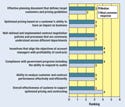Medtech Revenue Management Practices 4188
A new survey of medical device firms looks to benchmark industry pricing, contracting, and incentive practices.
MARKET ANALYSIS
Sidebars: |
Among today's medtech companies, contract sales are often more than 75% of U.S. revenues, and sometimes account for the full total of company sales. Because such sales can often spell the difference between success and failure in achieving aggressive revenue and profit targets, it is imperative that medtech executives understand how best to manage their companies' pricing and contracting practices.
Traditionally, medical technology companies have sought to gain market share by employing contract strategies such as discounts and incentives. But over the years, the increasing number and complexity of such practices have created significant management and measurement problems.
|
Figure 1. (click to enlarge) The marketing, sales, and finance departments drive key business processes contained within the revenue management life cycle. |
This article presents and analyzes findings and trends revealed in the 2006 Revenue Management Excellence Survey, an industry survey designed to help medtech companies benchmark their performance and identify best practices for pricing and contracting. The 2006 Revenue Management Excellence Survey was conducted by Computer Sciences Corp.–Global Health Solutions (El Segundo, CA) and Model N Inc. (Redwood Shores, CA). The survey identifies and examines medtech manufacturer trends and initiatives related to revenue management.
Key Issues
Key goals of the 2006 survey included capturing the outlook for medical technology contracting, understanding how medical technology companies view their revenue management capabilities, and discovering where medtech companies plan to invest in order to improve processes and systems in anticipation of future requirements. This article presents and analyzes findings and trends relative to these areas.
Medtech Macro Issues. Industry observers have typically estimated that medtech contract sales represent 80–90% of gross revenues. But the results of the survey show that respondents on average see contract U.S. sales at about 69%, accounting for a share of business that is somewhat lower than the industry estimate. Even so, negotiated revenues through contract-based sales still dominate medical technology sales today, with contracts between manufacturers and healthcare providers such as hospitals or long-term-care facilities being quite common.
|
Figure 2. (click to enlarge) Medtech company contract and noncontract sales revenues, by customer segment. Source: 2006 Revenue Management Excellence Survey. |
In many cases, contracts are negotiated by intermediaries on behalf of end customers such as hospitals. Such intermediaries include group purchasing organizations (GPOs), integrated delivery networks, and integrated health networks. Such institutional contracts represent more than half of all contract sales revenues (see Figure 2).
Respondents at the high end of the scale reported having as many as 11,000 active contracts with their customers while those responding at the low end of the spectrum reported as few as 70 live contracts at any given time. An average of 4424 active contracts was calculated across responses.
Macro Company Topics. In light of the significance of contracting to medtech firms, satisfaction with contracting and pricing performance is an important internal indicator of contracting success for medical technology companies. The survey therefore asked respondents to rank their satisfaction with key contract and pricing performance processes managed by their marketing, sales operations, finance, and accounting departments. Respondents ranked their satisfaction on a scale of 1–6, with 1 representing the lowest level of satisfaction and 6 representing the highest degree of satisfaction.
|
Figure 3. (click to enlarge) Satisfaction of respondents with their companies' performance against key criteria |
For the most part, respondents view their companies as failing to score at the high end on most of the measures. On average, respondents ranked their satisfaction in the mid-range or just below on almost all of the performance satisfaction metrics. These responses suggest that survey participants feel their companies' performance is less than optimal in the areas of pricing strategy effectiveness, alignment of sales objectives to corporate profitability objectives, and effectiveness of systems and processes to support pricing and contract optimization (see Figure 3).
Survey respondents indicated that one of the primary strategies their companies employ to deal with greater contract complexity and increasing data volume is to assign additional personnel to support revenue management activities. According to respondents, the greater the number of active contracts in any area of business, the greater the number of personnel tasked with managing the contracting life cycle for that business segment.
In addition, the majority of respondents expect the pricing and contracting environments at their firms to become more complex over the next three years. Nearly 90% of respondents anticipate a “somewhat greater” or “much greater” increase in contracting volume and complexity during that period.
Medtech Revenue Management Trends
In order to delve deeper into top areas of concern and discover whether companies are investing in specific processes and systems, the survey asked respondents to rank several contract and pricing metrics that are considered key components of the revenue management life cycle (see sidebar).
Pricing and Contracting Strategies. In medtech companies, the development of pricing and contracting strategies is typically a function of product or brand managers and marketing departments. Key objectives of pricing and contracting strategies include developing customer segmentation strategies and go-to-market plans as well as creating pricing guidelines, templates, and profitability and margin requirements to be used by salespeople. However, nearly half of all respondents to the 2006 survey indicated that they feel that their companies lack the necessary information to determine the best marketing and pricing strategies.
Accompanying this perception is a sense that the process of developing pricing and contracting strategies is prone to manual and inefficient turnaround times. Among survey respondents, 80% reported that such processes are resulting in wasted time. And nearly three-fourths reported that poor pricing strategies and guidelines—or those that are implemented poorly—are resulting in revenue loss.
Offer and Contract Development. This area typically encompasses a set of business processes and systems that are the responsibility of the sales and sales operations departments. Salespeople work closely with their back-office counterparts in sales contract and pricing operations to develop request-for-proposal responses; to negotiate contracts; and to ensure that necessary checks and validations, profitability analyses, and approvals of discounts and proffered customer incentives are in place.
|
Figure 4. (click to enlarge) Availability of field-use tools that enable a medtech company's sales force to analyze margin and profitability for a contract proposal. Source: 2006 Revenue Management Excellence Survey. |
According to the responses, survey participants are concerned that their salespeople are spending too much time on manual processes and paperwork, with the average time spent on such development-related work at 34% of selling time. One company estimated that its reps were spending as much as 90% of their time on paperwork. Additionally, nearly two-thirds of respondents stated that no automated support or system is available for analyzing the profitability of a proposal or offer (see Figure 4). In 70% of the survey participants' companies, salespeople have no access to contract or pricing data while creating, managing, and negotiating an offer.
Pricing and Contract Management. In this set of business processes, salespeople and sales operations are responsible for executing contracts and maintaining them once they are live. They must ensure that only the right customers qualify for discounts and incentives; that the company correctly captures the value of customer commitments; and that contractual and pricing implementations, amendments, and other updates are delivered to distributors, customers, and systems on a timely basis.
One critical differentiator between companies in ensuring the effectiveness and efficiency of these processes is the ability of the field sales force and sales operations to collaborate in the development of contractual pricing offers to customers. For the survey, 30% of respondents reported that their companies do not have access to key pricing and contracting systems to facilitate the offer development process. Therefore, in addition to reporting that salespeople do not have access to pricing and contracting information during offer development, many respondents feel that their companies in general also do not have information systems to house or manage such information.
Without ready access to systems or data during the offer development process, companies can find themselves at a disadvantage. Customers may end up getting terms they do not deserve or otherwise being charged inappropriate prices. Survey respondents acknowledged such deleterious effects as results of not having access to a pricing and contracting system during the offer process. Respondents indicated that their sales forces' ability to make good decisions and to be competitive is harmed as a result of manual processes or the unavailability of good pricing and contract information. As a direct consequence, 70% of the respondents reported that the lack of such systems interferes with the attainment of revenue goals.
Performance Compliance and Analysis. Medical technology sales contracts typically guarantee customers better pricing and discounts than would normally be available through distributors or catalog-based sales. Such contracts often require customers to commit to meeting specified purchase targets, and these arrangements are important considerations for manufacturers in meeting revenue targets. However, continual monitoring is required to ensure that the conditions related to customers' discounts are being fulfilled.
For the 2006 survey, however, 30% of responding companies reported that they do not track their customers' history of compliance to contract commitments. For those that do, manual systems are used in at least 30% of the cases. An additional 40% opted not to provide information as to how they track customer compliance with contract commitments.
Companies reported that on average nearly 20% of their contracts were out of compliance, with one company stating that up to half of its contracts were likely out of compliance with revenue and profitability targets. Nearly half of the respondents reported offering expired prices to their customers on an ongoing basis. While 60% of the respondents did not respond to the survey's question regarding compliance reporting frequency, 20% of the companies responding said they undertake compliance audits on at least a monthly, quarterly, or annual basis.
Settlement or Payment Processing. In exchange for guaranteed purchase commitments, medtech manufacturers offer a variety of incentives to their contract customers and other brokers, such as GPOs. The 2006 survey sought to investigate the level of manufacturers' satisfaction with the handling of these incentive mechanisms as well as the processing and payment of distributor-related financial settlements.
Overall, respondents reported that their companies see a significant amount of off-invoice price erosion resulting from overpayments on incentives and trade settlements. More than a third of all respondents reported that they are overpaying to some extent on these financial settlements, with the majority of the perceived overpayments occurring on distributor rebates and incentive rebates. Respondents indicated that they are overpaying by close to 10% on all incentive payments to customers and in the 5–7% range on other settlement structures, such as distributor rebates. In one case, a respondent reported as much as 40% overpayment.
Investing and Improving
Against the backdrop presented in the previous section, the survey asked companies to share information regarding their areas of priority and investment in revenue management. When ranking company satisfaction with current systems, close to 50% of the responses indicated poor to average satisfaction, with 10% of respondents stating that they were very satisfied with current systems and 30% saying they were relatively satisfied.
From an overall compliance and regulatory standards perspective, respondents expressed satisfaction that their companies are doing well to manage major considerations relating to government pricing and contracting standards, Sarbanes-Oxley requirements, and internal controls mandates.
Companies ranked “gaining visibility to underperforming customers and products” and “gaining visibility to negotiate profitable deals through predeal analysis” as the critical areas of focus for improving their pricing, margin, and revenue performance. Nearly 70% of the respondents followed that response by saying that they plan specific initiatives in the coming year to overhaul or buy new revenue management systems.
Conclusion
Medtech manufacturers must manage complex business processes and large data volumes, and they can experience significant financial losses when such management is lax. Poorly analyzed and poorly measured pricing strategies and resulting unprofitable deals may be amplified by procedural inefficiencies, poorly managed information, customer dissatisfaction, and risk of regulatory noncompliance—all of which can contribute to price and revenue erosion.
On average, survey respondents ranked their current performance relative to contract and pricing strategy management, process, and execution as less than optimal. One tactic being used to compensate for a lack of automation or systems support is for companies to invest in higher headcounts. Manual processes and spreadsheets are still widely used, with some companies still having the majority of their processes supported by manual spreadsheets.
Overall, responses to the 2006 survey indicate that representatives at medtech companies recognize a deleterious impact on revenue when they do not have visibility into and tools to manage key revenue information. They also recognize a need for controls and integrated processes in managing the complete revenue life cycle. In light of such recognition, many are investing in initiatives to address these issues.
Gopkiran V. Rao is director of industry marketing at Model N Inc. (Redwood Shores, CA). Robert S. Matsuk is pricing and contracting solution director at Computer Sciences Corp. (El Segundo, CA).
Copyright ©2007 MX
About the Author(s)
You May Also Like





.png?width=300&auto=webp&quality=80&disable=upscale)
